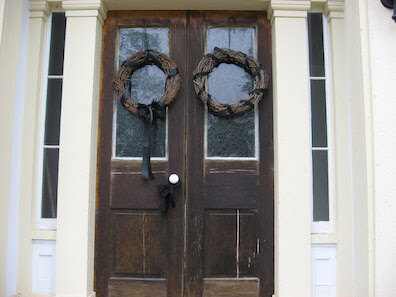Crape
Crape
In Brief
Among many other Victorian-era funeral customs seen in the cemetery chapter, Joyce casts several glances at the use of "crape" to signify mourning. Crepe (from the French crêpe) is a thin, crinkled, sheenless fabric made most often from silk. When associated with mourning it was usually spelled with an "a."
Read More
As the funeral carriages start to move at the beginning of Hades,
they pass "number nine with its craped knocker, door ajar.
At walking pace." Houses of mourning were conventionally
decorated with crepe––black in most cases, but white when the
deceased was a child. Ribbons of the fabric were hung from
doorknobs, knockers, or wreaths, and larger swaths were
sometimes draped around windows and door frames. According to
a 2021 blog by Cathy Wallace on the Billion Graves website
(blog.billiongraves.com/preparing-the-victorian-home-for-a-funeral/),
knockers were often covered with the cloth to keep visitors
from disturbing the family with loud noises. "Visitors were
expected to just knock softly. Sometimes the door was even
left ajar so they could just walk in." Joyce's narrative notes
this practice of leaving the door ajar, and adds the further
detail of starting the procession at a walking pace to
preserve the air of quiet solemnity.
Later, as he looks out the window of the carriage moving down Great Brunswick Street, Bloom sees "A man in a buff suit with a crape armlet. Not much grief there. Quarter mourning. People in law perhaps." Wearing a black crepe ribbon around a sleeve was another conventional expression of mourning. Bloom notes the minimal nature of this gesture (at the other extreme, Victorian widows were expected to dress entirely in black crape for one year), suggesting either that this mourner was not very close to the deceased ("People in law perhaps") or that a considerable amount of time has elapsed since the death (Victorian conventions prescribed a period of full mourning, usually for one year, followed by half-mourning and then "Quarter mourning").
In the cemetery's mortuary chapel Bloom notices "Crape
weepers." These are probably not paid mutes, as
Gifford supposes, but decorative ribbons on people's clothes,
like the armband that Bloom has spotted on the sidewalk of
Great Brunswick Street. Slote cites a definition in the OED:
"Weeper: a badge of mourning, usually on a man's sleeve, but
also around his hat." Just after this, Bloom goes on to take
note of "Blackedged notepaper." Mourners were expected
to write their letters on stationery that was surrounded by a
black border.
Although the narrative does not say so, black crepe may very
well figure also in the two "wreaths" that are loaded
into the hearse at the Dignam house, unloaded at the gates of
the cemetery, and carried into the mortuary chapel. Some
Victorian and Edwardian funeral wreaths were woven from
greenery like yew or laurel and tied with black ribbons, but
others were constructed entirely of folds of crape.
These various codified expressions of grief constituted a
visual language for Victorians and Edwardians, not only
alerting them to the presence of recent deaths in their
communities but also giving them information about when the
death had occurred, what kind of relation the mourner had to
the deceased, and thus how others should regard that person.
In this respect crape functioned in a manner similar to the language of
flowers, which had its own conventional symbols for
grief and mourning. As Bloom walks about Dublin on June 16,
his black suit signifies the possibility of personal loss to
people who do not know him well, prompting solicitous
inquiries like M'Coy's in Lotus Eaters:
His eyes on the black tie and clothes he asked with low respect:The same thing happens when Bloom crosses paths with Josie Breen in Lestrygonians, but this time he is content to encourage her solicitous concern:
— Is there any... no trouble I hope? I see you're...
— O, no, Mr Bloom said. Poor Dignam, you know. The funeral is today.
— You're in black, I see. You have no...Later in the same chapter, a considerate pub owner waits until Bloom has gone outside to ask an obtuse customer what kind of mourning Bloom's clothes may signify:
— No, Mr Bloom said. I have just come from a funeral.
Going to crop up all day, I foresee. Who's dead, when and what did he die of? Turn up like a bad penny.
— O, dear me, Mrs Breen said. I hope it wasn't any near relation.
May as well get her sympathy.
— Dignam, Mr Bloom said. An old friend of mine. He died quite suddenly, poor fellow. Heart trouble, I believe. Funeral was this morning.
— I know him well to see, Davy Byrne said. Is he in trouble?
— Trouble? Nosey Flynn said. Not that I heard of. Why?
— I noticed he was in mourning.
— Was he? Nosey Flynn said. So he was, faith. I asked him how was all at home. You're right, by God. So he was.
— I never broach the subject, Davy Byrne said humanely, if I see a gentleman is in trouble that way. It only brings it up fresh in their minds.
Bloom will wear black clothes only on the day of the funeral, as he had no close ties to Dignam. Stephen, however, has been wearing them for nearly a year, as the old strict Victorian conventions demanded of a grieving son.

Mourning wreaths and doorknob decorated with black ribbons, date and place unknown. Source: passionforthepast.blogspot.com.